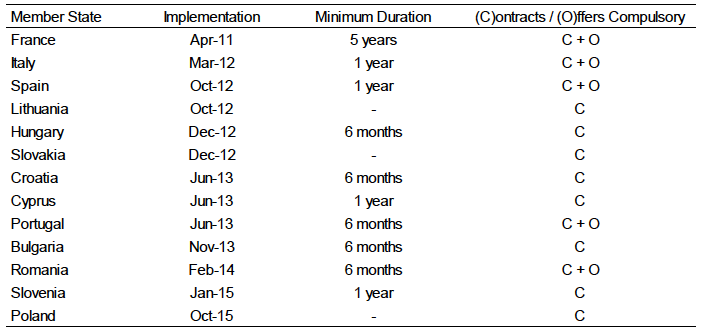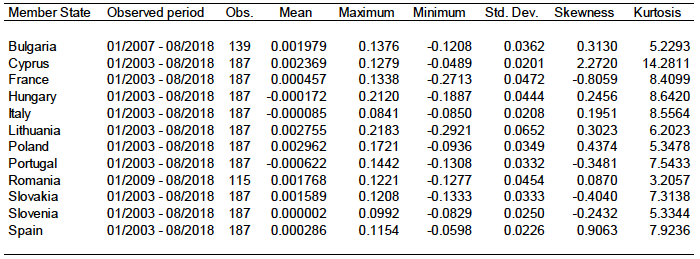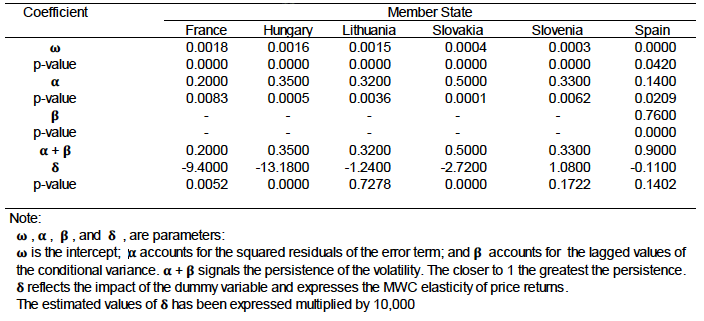Dairy contracts in European countries: research
Analysis on the current state of the dairy sector and supply chains within European countries and the application and impact of mandatory written contracts and their suitability and potential application in Scotland.
4. Introduction of mandatory contracts and farm price volatility
Key points
- This analysis investigated the impact of the implementation of mandatory written contracts (MWC) under the EU agricultural Common Market Organisation (CMO) regulation in raw milk price volatility in twelve member states using time series models.
- The results showed evidence that in three of these members states (France, Hungary, and Slovakia) milk price volatility decreased after the internal implementation of MWCs.
- In the rest of the countries under consideration the results found were varied, with raw milk prices’ variance either found to be constant or to vary in a non-significant manner over the period studied. This could be due to a variety of causes such as that written contracts were commonly used before the 2012 Milk Package.
- It should be highlighted that the CMO regulation included not only prescriptions about the introduction of MWC but also other recommendations in order to improve the position of dairy farmers in the supply chain (e.g., implementation of dairy farmers’ PO and IBOs), as to improve producers bargaining position and transparency within the dairy supply chain.
4.1 The purpose of this section is to investigate the impact that the implementation of MWCs under the EU agricultural Common Market Organisation (CMO) regulation had on raw milk price volatility among twelve member states. Table 3 presents the countries implementing the contracts.
4.2 It is important to emphasise that although volatility is frequently mentioned on the discussions of MWCs (e.g., Scottish Government ITT), the purpose of those contracts it is not to reduce volatility but to provide transparency on the relationships between milk producers and their customers.
4.3 Volatility is a directionless measure of the variability of a price over time (Gilbert and Morgan, 2010). Price movements are embedded in the market’s clearing mechanism that enables demand and supply of any product to match. Price changes may reflect improvements in competitive advantages along the supply chain, as they may also disclose changing preferences on consumers that allow for efficient relocation of resources (O'Connor and Keane, 2011). In addition, unexpected large price variations may occur attending to other multiple factors, accordingly markets that behave in that manner are described as volatile (FAO and OECD, 2011).
Table 3: MWCs implementation in Europe

Source: European Commission, 2016.
4.4 Impacts caused by excessive market volatility may be varied. Some examples could be among others: inefficient investment induced by risk averse behaviour, non-optimal production decision-making, or food security issues (FAO and OECD, 2011; Piot-Lepetit and M'Bareck, 2011).
4.5 Most agricultural markets possess characteristics that may stimulate volatility. It is common that agricultural markets exhibit price-inelastic demand and supply where the quantities supplied and demanded vary less than price in proportion. On the other hand, agricultural output may be dependent on weather conditions. As a result of both circumstances small variations in production may prompt huge variations in price (Piot-Lepetit and M'Bareck, 2011).
4.6 The data consisted of historical time-series of monthly averages prices of raw cow’s milk at real fat content paid to milk producers expressed in euros per 100 kilograms. The data were obtained from the European Commission’s Milk Market Observatory on October 2018 for all those EU members that had implemented in their internal regulation the utilisation of MWCs for the marketing of raw milk (European Commission, 2018). The period covered in this study extends from January 2003 to August 2018, except for Bulgaria and Romania, whose series start at January 2007 and 2009 respectively due to data availability. Croatia has not been included in this analysis because there are no available data previous to the implementation of MWCs in June 2013.
4.7 The analysis of price volatility deals with the measurement of its variation over time. Hence, volatility analysis must focus on the variance of the probability distribution of the prices (Gilbert and Morgan, 2010). As it is customary in this type of analysis the log returns of monthly average prices of raw milk were used to assess how the implementation of MWCs has affected prices’ volatility. Table 4 provides descriptive statistics of the series under observation. It may be observed that all of the series exhibit the excess kurtosis[5], with all values larger than 3, that is a sign of volatility (O'Connor and Keane, 2011).
Table 4: Descriptive statistics

Note: Data are expressed as li returns (Price t /Price t-1) of the average monthly prices of raw milk obtained as €/100kg
4.8 In terms of methods, the analysis used the Generalised Autoregressive Conditional Heteroscedasticity (GARCH) model, which is a statistical time series method that allows modelling both the mean of a variable (in this case the raw milk price) and its variance. Since their development, GARCH models have been extensively used to analyse agricultural commodity markets volatility (Piot-Lepetit and M'Bareck, 2011; O'Connor and Keane, 2011; Gilbert and Morgan, 2010; Yang, et al., 2001).
4.9 This analysis extends the use of the GARCH model to test the hypothesis that raw milk price volatility changed in selected European dairy markets associated to the introduction of MWCs as part of the implementation of the EU-CMO regulation. The GARCH model allows doing so because it not just may properly describe the time-varying pattern of price variability, but in addition the model enables the inclusion of explanatory variables in the specification of the conditional variance.
4.10 Thereby, following Enders (2015) a dummy variable equal to 0 before the introduction of the MWCs and equal to 1 after the introduction, was created and added to the model of each country under consideration. The statistical significance of the dummy will indicate whether the introduction of MWCs has affected or not raw milk price volatility, with its positive or negative sign indicating the direction of the change (Yang, et al., 2001). Note that this assumes that the effects over the price volatility start from that point onwards, however such effect may take time to materialise and produce the expected effects.
4.11 According to the model selection strategy, a preliminary step consists of checking the presence of conditional heteroscedasticity on the residuals of the modelled series. The tests for Bulgaria, Cyprus, Italy, Poland, Portugal, and Romania’s time-series did not find ARCH effects on the series. In other words, the variance of the log-return of the prices in these series remained constant. In other terms, these countries did not show any effect that the introduction of the MWCs changed the volatility of raw milk prices.
4.12 The rest of the time-series in which conditional heteroscedasticity effects on the residuals were detected (i.e., France, Hungary, Lithuania, Slovakia, Slovenia, and Spain) were subsequently modelled as GARCH processes. The results are presented in Table 5. The sign of the parameter ( ) for each country indicates whether the introduction of the contracts have brought a reduction on the variance of the milk prices of the country. Note that although this was observed in five of the six cases, only three cases were statistically significant.
) for each country indicates whether the introduction of the contracts have brought a reduction on the variance of the milk prices of the country. Note that although this was observed in five of the six cases, only three cases were statistically significant.
Table 5: Conditional variance equation estimates

4.13 Therefore, the results indicate that at least in three of the countries where MWC have been implemented (i.e., France, Hungary, and Slovakia) raw milk price volatility has decreased after their introduction.
Contact
Email: socialresearch@gov.scot
There is a problem
Thanks for your feedback